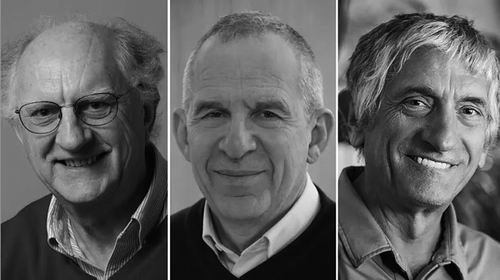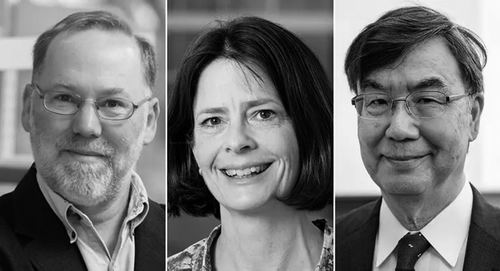

From left to right are Richard Roberts, Peter Ratcliffe, Joachim Frank and Richard Henderson. Image source: Nobel Prize official website
On a weekend at the end of March 1953, the Cavendish Laboratory of the University of Cambridge, UK. James Watson and Francis Crick handed a manuscript of only 900 words to the temporary typist, Watson's sister, and told her that she was participating in the field of biology since Darwin's theory of evolution. The most sensational event ever.
On April 25 of that year, the "Nature" magazine published this article. The article begins with: We intend to propose a deoxyribonucleic acid (DNA) salt structure, this brand-new structure has considerable biological significance.
This is the official release of the DNA double helix structure. The article, jointly published by Watson and Crick, is entitled "The Molecular Structure of Nucleic Acids: The Structure of Deoxyribose Nucleic Acid." At the end of the article, Crick originally wanted to discuss the biological significance of the article at length, but Watson lacked confidence in the double helix structure and was worried about being slapped in the face. After careful consideration, Crick resisted the urge and stated, "We note that the specific pairing we hypothesize directly suggests a possible replication mechanism for genetic material."
Two young people, one 25 years old and the other less than 37 years old, thus opened the curtain of modern molecular biology, which led to the subsequent gene sequencing technology, gene recombination technology and gene editing technology. By April, the 70th anniversary of the discovery of the DNA double helix, the paper had more than 8,500 citations.
The previous relevant historical documents are already overwhelming, so how to commemorate the 70th anniversary? We proposed two key words that are relevant to the moment: young people and artificial intelligence.
How, we wondered, can young people today be as successful as Watson was at the age of 25 70 years ago? We want to know, after the surge of artificial intelligence, especially ChatGPT, how to tap human innovation ability, and what kind of challenges has our education faced?
To this end, we wrote letters to more than 80 Nobel Prize winners, and so far we have received valid answers from 4 Nobel Prize winners. They are: Richard Roberts, winner of the 1993 Nobel Prize in Physiology or Medicine, who discovered introns and exons in eukaryotic genes in the 1970s; 2019 Nobel Prize in Physiology or Medicine Winner Peter Ratcliffe, who studied the mechanism by which cells sense and adapt to changes in oxygen; Joachim Frank and Richard Henderson, winners of the 2017 Nobel Prize in Chemistry, both for cryomicroscopy Awarded for contributions to the field of technology.
Keyword 1: young people
Although he became famous at a young age, Watson later underestimated the creativity of young people.
In 1972, Watson, 44, was trying to sequence the DNA of a virus called SV40. As the director of Cold Spring Harbor Laboratory in the United States, he needs to recruit new forces. Roberts, 29, came into his sights.
At this time, Roberts, a Ph.D. in chemistry, had successfully transformed into a molecular biologist through postdoctoral training at Harvard University. He used sequencing techniques pioneered by chemist Frederick Sanger in his RNA-sequencing work and published two Nature papers. He had planned to return to the UK after completing his postdoctoral work.
The interview took only 10 minutes, and Watson was talking most of the 10 minutes. The famous Watson, coupled with high salary, laboratory support and all the necessary start-up funds, made it impossible for Roberts to refuse the position. Watson wants him to go ahead and sequence the DNA of SV40 using Sanger's sequencing technology, which sequences the RNA after the DNA has been copied into RNA.
It was a research scientist position with an independent lab, and Roberts had room to make a big difference. However, upon entering Cold Spring Harbor Laboratory, he discovered that two groups were already doing the exact same work. He thought it foolish to try the same method a third time, when restriction endonucleases (hereafter referred to as restriction enzymes) had been discovered, allowing smaller fragments of DNA to be obtained.
Roberts is excited about it. He told the "China Science Daily" that if more restriction enzymes are found, DNA sequencing seems to be within reach, "I started to isolate restriction enzymes, hoping to use them to develop direct DNA sequencing methods."
At the time, however, Watson disliked Roberts' self-assertion. "We argued a lot about what I was doing," Roberts recalls. In the end, Roberts didn't succeed, but he discovered many different restriction enzymes that cut DNA strands, which actually helped him start the biotechnology industry.
Roberts has a keen business acumen. In 1974 he tried to persuade Watson to let Cold Spring Harbor Laboratory start a company that would manufacture and sell restriction enzymes. But Watson declined the offer, saying it was not profitable.
The Roberts laboratory obtained a large number of restriction enzymes. In the 1970s and early 1980s, about 75 of the nearly 100 known restriction enzymes were isolated by his laboratory.
But he didn't come for the patent. In contrast, between 1972 and 1985, they made no effort to patent these enzymes. They also created a database called REBASE of all known restriction enzymes. Roberts still runs it to this day and updates it daily.
In 1992, Roberts joined New England Biotechnology Limited, a restriction enzyme business, as chief scientific officer.
Looking back on the experience of working with Watson, Roberts said with emotion to "China Science Daily": "I always look for those who are passionate about science, especially those who want to be independent, not just do what they are told. They Scientists tend to be the most creative, and when there is enough money to support their dreams, they usually do very well."
Keyword 2: artificial intelligence
Surprisingly, the attitudes of the four Nobel Prize winners towards artificial intelligence are far less than the popularity of domestic public opinion, and their evaluations are even negative.
It was the field of structural biology studied by Frank and Henderson that was first impacted by artificial intelligence. The spoiler is AlphaFold, a protein structure prediction program developed by DeepMind. The latter released its first version on July 22, 2021, predicting more than 350,000 protein structures in one fell swoop, and this data reached 200 million a year later. In the past 60 years, scientists have determined 170,000 protein structures through techniques such as X-ray crystallography, cryo-electron microscopy and nuclear magnetic resonance.
Are structural biologists out of a job? Frank gave a resolutely negative answer: this absurd idea is a fundamental misunderstanding of science as a real-world inquiry, one that acquires knowledge through a cyclical process of hypothesis-building and experimentation, rather than by building on existing (limited) knowledge. ) simulation of knowledge.
Henderson also criticized the AlphaFold for being overhyped, but appreciated the way it conveniently provided data. He also and his collaborators clarified their views in the 2022 issue of "Science": AlphaFold and RoseTTAfold developed by the University of Washington are much more accurate in predicting protein structures than previous methods, but this does not mean that the protein folding problem has been solved. solve. The structure predictions of these prediction programs may be accurate enough to facilitate the determination of experimental structures, but they cannot independently provide a detailed understanding of molecular and chemical interactions, let alone dynamic structural changes in specific sequences.
They concluded that these prediction procedures are not the final answer and that despite significant advances in protein structure prediction, experimental structure determination remains essential.
As for the current popular ChatGPT, Henderson stands on a grander historical perspective. People will use AI like printed books, he said, helping to democratize knowledge that was often restricted to religious figures with monopoly power. The technological revolution after printing, such as audio recording, video recording, Wikipedia, smartphones, speech recognition and automatic language translation, has accelerated the progress of knowledge, "so currently ChatGPT is just another small step in it".
Frank has a negative opinion of ChatGPT: "I've never understood why people are keen to perfect a tool that will undoubtedly be used by the government for social control, plagiarism, identity theft, and misrepresentation. (Despite) my personal experience Limited, ChatGPT didn't impress me because of the large number of factual errors, but clearly the next generation of tools will improve."
Roberts' view is close. He said: "I call ChatGPT CheatGPT (cheat GPT) because I can easily see that students can misuse it. Although the program is still developing, I think there is a lot of room for inappropriate use. I think programmers need to find a way to recognize when it's being used."
Although ChatGPT has not been favored by these Nobel laureates, we still have to ask: Will ChatGPT disrupt our education system? Is knowledge acquisition still the primary goal of education?
Ratcliffe is paying attention to this question. As well as Oxford, he has worked since 2016 at the Francis Crick Institute in London. Knowledge builds upon each other in unexpected ways, he said, "so I expect that the human mind will still play an important role in connecting different fields of knowledge, solving problems or defining problems".
However, Ratcliffe pointed out that as the body of knowledge increases dramatically, the pressure on education (and children) will also increase. He is surprised by the laxness of many countries in updating their education systems and ignoring investment in the education industry. "I think we must revise our teaching content to stimulate the passion of discovery, that is, the further acquisition of knowledge".
Specifically, he hopes to teach science through the history of science, so that science education can place more emphasis on how to discover new knowledge, rather than just focusing on instilling knowledge.
(Original title "To Commemorate the 70th Anniversary of the Discovery of the DNA Double Helix, We Ask Nobel Prize Winners")


